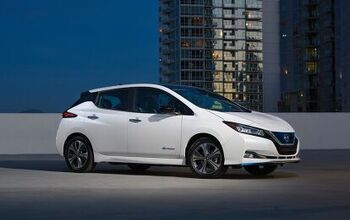New Nissan Battery Keeps Going, and Going, and Going

Lithium is known as a reliable treatment of depression. A double dose of lithium with a touch of cobalt is now prescribed by Nissan to cure range anxiety and other assorted phobias afflicting owners of plugins. The Nikkei [sub] writes that Nissan “has nearly completed development of a lithium ion battery that can power an electric vehicle for 300km on a single charge, about double the capacity currently possible.”
Nissan hopes to sell cars powered by the Energizer-bunny of all plugins by 2015.
Otaku (nerd) alert:
According to the Nikkei, “lithium ion battery capacity is largely determined by electrode performance. Nissan is raising capacity by improving the positive electrode, specifically, using nickel and cobalt, not only manganese. The new battery can store about twice as much electricity as batteries with positive electrodes made only from manganese. It is robust enough for practical use, able to withstand 1,000 or so charge cycles.”
Nissan figures the new double-dose battery will cost about the same as conventional lithium ion ones to produce. The amount of (obscenely expensive) cobalt is negligible, says the Nikkei.

Bertel Schmitt comes back to journalism after taking a 35 year break in advertising and marketing. He ran and owned advertising agencies in Duesseldorf, Germany, and New York City. Volkswagen A.G. was Bertel's most important corporate account. Schmitt's advertising and marketing career touched many corners of the industry with a special focus on automotive products and services. Since 2004, he lives in Japan and China with his wife <a href="http://www.tomokoandbertel.com"> Tomoko </a>. Bertel Schmitt is a founding board member of the <a href="http://www.offshoresuperseries.com"> Offshore Super Series </a>, an American offshore powerboat racing organization. He is co-owner of the racing team Typhoon.
More by Bertel Schmitt

































Comments
Join the conversation
People speak of H2 as if it is some easy to exploit universal panacea. To the best of my knowledge, H2, in the form we can use it, comes from two sources: 1) electrolysis (i.e. more electrical generating capacity will have to be brought on-line), and/or b) as a by-product of refining petroleum. I will be interested to see how many others are identified by the B&B in response to this post.
What Folkdancer is saying is exactly why the Electric Power Research Institute supports development of electric cars. (Please note: I'm going to be one of the last people to buy an electric car unless ICE becomes unaffordable for me. I love ICE, and I love it straight, like my bourbon.)
Other sources of H2 would include from alcohol, or natural gas. It would be a good storage medium for electricity from wind and solar, although it would be considerably more efficient to store in batteries, if decent batteries can be developed. (Watch this site 20-25 years from now imo.)